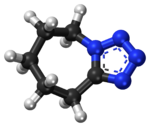Pentylenetetrazol
 |
|
 |
|
| Clinical data | |
|---|---|
| ATC code | |
| Identifiers | |
|
|
| CAS Number | |
| PubChem CID | |
| ChemSpider | |
| UNII | |
| KEGG | |
| ChEBI | |
| ChEMBL | |
| ECHA InfoCard | 100.000.200 |
| Chemical and physical data | |
| Formula | C6H10N4 |
| Molar mass | 138.171 g/mol |
| 3D model (Jmol) | |
|
|
|
|
|
|
|
Pentylenetetrazol, also known as pentylenetetrazole, metrazol, pentetrazol (INN), pentamethylenetetrazol, Corazol, Cardiazol or PTZ, is a drug formerly used as a circulatory and respiratory stimulant. High doses cause convulsions, as discovered by the Hungarian-American neurologist and psychiatrist Ladislas J. Meduna in 1934. It has been used in convulsive therapy, and was found to be effective—primarily for depression—but side-effects such as uncontrolled seizures were difficult to avoid. In 1939 pentylenetetrazol was replaced by electroconvulsive therapy, easier to administer, as the preferred method for inducing seizures in England's mental hospitals. In the US its approval by the FDA was revoked in 1982. It is used in Italy as a cough suppressant.
The mechanism of pentylenetetrazol is not well understood, and it may have multiple mechanisms of action. In 1984, Squires et al. published a report analyzing pentylenetetrazol and several structurally related convulsant drugs. They found that in vivo convulsant potency was strongly correlated to in vitro affinity to the picrotoxin binding site on the GABA-A receptor complex. Many GABA-A ligands are effective anticonvulsants, such as the sedatives diazepam and phenobarbital, but presumably pentylenetetrazol has the opposite effect when it binds to the GABA-A receptor.
Several studies have focused on the way pentylenetetrazol influences neuronal ion channels. A 1987 study found that pentylenetetrazol increases calcium influx and sodium influx, both of which depolarize the neuron. Because these effects were antagonized by calcium channel blockers, it was concluded that pentylenetetrazol acts at calcium channels, and it causes calcium channels to lose selectivity and conduct sodium ions as well.
One study assessed the effect of cAMP, its analogs and dependent protein kinase on pentylenetetrazole-induced seizure in vivo. The finding show that cAMP analog, as well as phosphodiesterase and protein kinase inhibitors affected the epileptogenic activity of pentylenetetrazole. This finding shows the involvement of cAMP, its downstream and upstream on pentylenetetrazole activity.
...
Wikipedia
